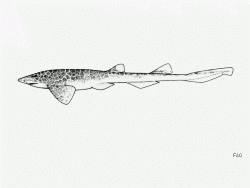select your film:


Izak Catsharks are endemic to Namibia and South Africa at depths usually at 150 to 300 m deep in the southeast Atlantic Ocean and the western Indian Ocean.
Biology and Behaviour
Izak catsharks are broad-headed and have crowded dark brown spots on a yellowish background which creates a net-like pattern along its back. Their underside is off-white with small black pores.
Male izak catsharks are larger than the females which is uncommon for sharks because female sharks are usually larger than males.
They can be found near or on the bottom of the sea and they prefer cooler temperate water, but can also be found in subtropical waters. They prefer 200 to 300 m depths on the west coast, and 100 to 200 m depths on the south coast. They feed on pelagic bony fish, fish offal, hagfish eggs, crustaceans and cephalopods.
Reproduction and Lifespan
Izak catsharks are oviparous and the eggs are laid in pairs – one egg from each uterus. Females mature between 40 to 45 cm, while males mature between 45 to 50 cm. They can grow up to 60 cm long.
The izak catshark is one of the very few shark species that show an increase in population size despite the presence of commercial fisheries in its range. Therefore, izak catsharks presumably have high fecundity.
Conservation and Tourism
The IUCN lists izak catsharks as least concern, and there are currently no conservation actions in place for this species. However, a shark management plan has recently been implemented in Namibia.
Do you have images or videos of Izak Catsharks?
Submit them to [email protected].
